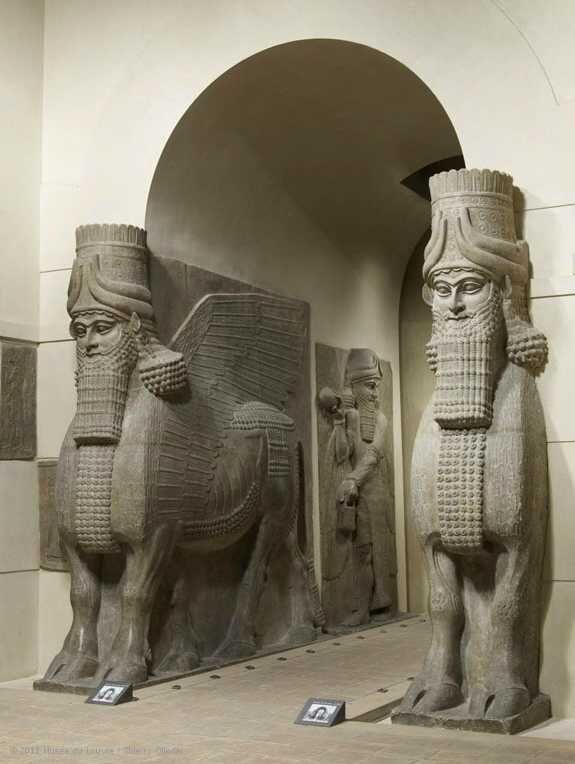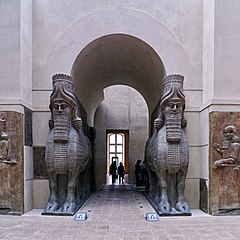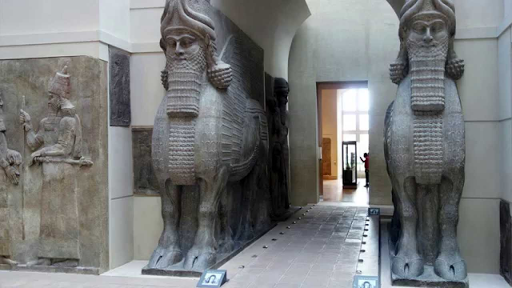The first change was the capital was moved to Dur Sharrukin present day Khorsabad and second the Lamassu was presented on a bulls body compared to a lions and seems to be slightly smiling. The Ziggurat at Ur was a fortress funerary monument palace temple platform Where were the Lamassu sculptures originally displayed.
Human Headed Winged Lion Lamassu Assyrian Neo Assyrian The Metropolitan Museum Of Art
Sargons palace gudeas lagash ashurbanipals palace ziggurat at ur.

. The Human-headed winged bull and winged lion Lamassu sculptures on display in the Metropolitan Museum of Art were believed to have been a part of the Assyrian palaces at Nimrud during the reign of Ashurnasirpal II 883- 859 BC. What were the most common themes in Assyrian art. It appears frequently in Mesopotamian artThe lamassu and shedu were household protective spirits of the common Assyrian people becoming associated later as royal protectors and were placed as sentinels.
These massive sculptures served as symbolic guards of Assyrian kings domain being placed at the entrance to both the city and palace gateways See Collins 2008 72. Originally unearthed in Rome and displayed in the Borghese Gallery it was sold to the occupying French and now sits in the Louvre. On a larger scale Lamassu would also flank the entrances of palaces as colossal sculptures in high relief in pairs.
As mentioned the Lamassu motif first appeared in royal palaces at Nimrud during the reign of Ashurnasirpal II and disappeared after the reign of Ashurbanipal who ruled between 668 BC and 627 BC. Correct answer to the question Where were the lamassu sculptures originally displayed. The gate and its lamassu were first excavated by Sir Austen Henry Layard in 1849 but.
This colossal sculpture of a winged-bull was one of a series that guarded the entrance to the throne room of Sargon II king of Assyria 721-705 BC in his palace at Khorsabad the capital city of the Neo-Assyrian Empire during his reignThis figure known as a lamassu from the textual sources is a composite mythological being with the head of a human the body and ears of a. Where were the lamassu sculptures originally displayed. In the Assyrian mythology there were human headed winged bullslions that were protective genies.
The Lamassu sculptures were recovered from where. What ethnic group is credited with the first system of writing known to man. The most famous colossal statues of Lamassu have been excavated at the sites of the Assyrian capitals established by King Assurnasirpal II reigned 883 859 BCE and King Sargon II reigned 721 705 BCE.
An American professor named Michael Rakowitz was commissioned to recreate this Lamassu sculpture and it is now displayed in Trafalgar Square in London. This replica was made with 10000 Iraqi date syrup cans and serves as a symbol of. The Assyrians envisioned a protective spirit that was part bull and part human and sometimes part eagle.
Sargons palace Gudeas Lagash Ashurbanipals palace Ziggurat at Ur Which culture is credited with the first system of writing known to humanity. The lamassu in museums today including the Louvre shown in our video as well the British Museum The Metropolitan Museum of Art and National Museum of Iraq in Baghdad and others came from various ancient Assyrian sites located in modern-day Iraq. In some cases the lamassu statues were accompanied by.
Originally unearthed in Rome and displayed in the Borghese Gallery it was sold to the occupying French and now sits in the Louvre. They were moved to their current institutional. This was possibly the first time when Europeans watched the mythical monsters.
Where were the lamassu sculptures originally displayed Written By fritcher Wednesday March 23 2022 Add Comment Edit Ancient Egyptian art must be viewed from the standpoint of the ancient Egyptians to understand it. The lamassu is a celestial being from ancient Mesopotamian religion bearing a human head bulls body sometimes with the horns and the ears of a bull and wings. Strengthening these bonds further were the so-called Panhellenic sanctuaries and festivals that embraced all Greeks and encouraged interaction competition and exchange for example the Olympics which were held at the Panhellenic.
The Ziggurat at Ur was a fortress funerary monument palace temple platform Where were the Lamassu sculptures originally displayed. To protect the household Lamassu were engraved in clay tablets and the tablet would then be buried under the doors threshold. 721-705 BCE Part of a collection at the Louvre in Paris France.
The Lamassu seen from the side from the palace Sargon II r. Currently representations of Lamassu are parts of collections at the British Museum in London Metropolitan Museum of Art in New York and The Oriental Institute in Chicago. Which work has a king approaching the god.
From what we can tell it seems that these sculptures were believed to protect the palace and king from evil supernatural forces as well. The first Lamassu appeared under Tiglath-Pileser in the 900s BCE. The reason for the Lamassus disappearance in buildings is unknown.

Lamassu History 2701 Wiki Fandom

Lamassus At The Louvre Thatmuse

Lamassu Backstory Article Assyrian Khan Academy
Colossal Lamassu Sculpture From The Palace Of Sargon Ii At Khorsabad Sargon Ii Google Arts Culture
Human Headed Winged Bull Lamassu Assyrian Neo Assyrian The Metropolitan Museum Of Art

25 Lamassu From The Citadel Of Sargon Ii Dur Sharrukin Modern Iraq Ap Art History


0 comments
Post a Comment